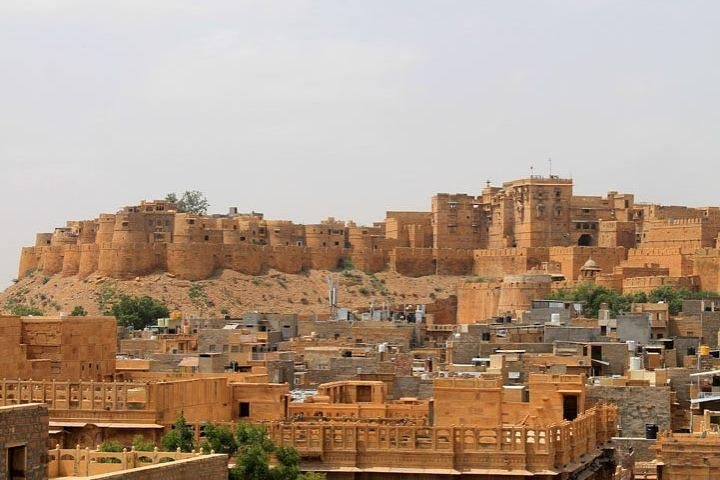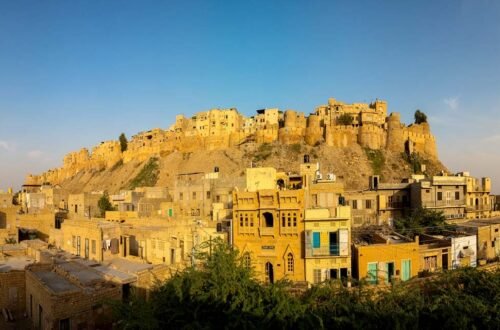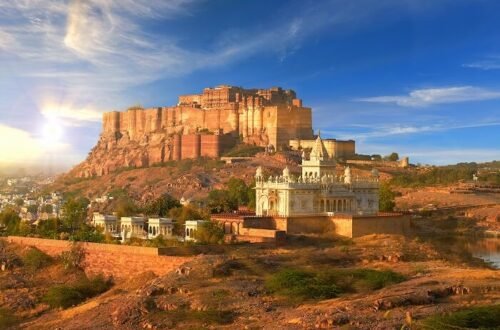Patwon Ki Haveli stands as one of Jaisalmer’s most distinguished landmarks, offering a glimpse into the city’s prosperous trading era. Located in the heart of the old city near the Jaisalmer Fort, this haveli (traditional mansion) is not a single structure, but rather a cluster of five distinct havelis built over a span of 50 years. It holds the distinction of being the first haveli constructed in Jaisalmer and is often noted for its intricate architecture and deep historical roots.
Historical Background of Patwon Ki Haveli
The haveli was commissioned by Guman Chand Patwa, a wealthy trader from the Patwa community, around 1805. He was known for dealing in gold, silver, brocade, and other luxurious textiles. The structure was built for his five sons, each of whom occupied one segment of the haveli. Despite the name suggesting a singular building, the Patwon Ki Haveli is actually a complex of five interconnected mansions, each bearing architectural details that reflect the affluence and craftsmanship of the period.
Though the Patwas were not originally from Jaisalmer, they chose the city as their base due to its proximity to major trade routes that connected India with Central Asia and Persia. The havelis were later sold off and came under the possession of different families and government bodies, some of which now function as state-managed heritage museums.
Architectural Highlights Worth Noting
The most striking feature of Patwon Ki Haveli is its detailed sandstone façade, intricately carved with floral patterns, jharokhas (overhanging enclosed balconies), and lattice screens. The yellow sandstone used throughout the construction blends seamlessly with the golden tones of Jaisalmer, earning the city its moniker – “The Golden City.”
Inside the haveli, visitors encounter expansive courtyards, winding staircases, frescoes, mirror work, and painted ceilings that showcase a blend of Rajputana and Mughal influences. The stone latticework not only offered privacy but also allowed air to flow through, demonstrating early Rajasthani strategies for climate control. This attention to both form and function continues to be a subject of architectural study.
Today, parts of the haveli house government offices, handicraft stores, and sections curated as museums. These exhibits display traditional artifacts, turbans, utensils, and artwork that highlight Rajasthani culture through the centuries.
Cultural Importance and Preservation
Beyond its architectural elegance, Patwon Ki Haveli holds significant cultural value. It reflects the wealth and social standing of the merchant class during Jaisalmer’s trading peak. The havelis are now part of conservation projects aimed at preserving the unique desert architecture of Rajasthan.
Preservation efforts have been particularly important in maintaining the haveli’s structural integrity, especially given the fragile nature of sandstone in desert climates. Some parts of the haveli have been restored under initiatives by the Rajasthan State Archaeology Department to maintain both the aesthetic and historical relevance of the building.
Visiting Tips and Best Time to Explore
Patwon Ki Haveli is easily accessible from most parts of the city, including the Jaisalmer Fort area and the main market. Entry fees apply for museum areas, while other parts may be open for free viewing. It’s advisable to visit during early morning or late afternoon to avoid peak heat and to enjoy softer light for photography, which brings out the detailing in the carvings.
Tourists often combine a visit to Patwon Ki Haveli with other nearby landmarks such as Salim Singh Ki Haveli and Nathmal Ki Haveli. These locations together provide a comprehensive look at Jaisalmer’s noble and merchant quarters.
Those traveling across Rajasthan often explore this haveli as part of a larger circuit, including cities like Jaipur and Udaipur. For instance, many travelers book convenient Jaipur to Udaipur Taxi services while planning their multi-city itineraries across the state.
Local Experiences Around the Haveli
The lanes surrounding Patwon Ki Haveli offer immersive experiences into local crafts and everyday Rajasthani life. From textiles and puppets to antique artifacts, the area is lined with small shops and artisans showcasing traditional goods. Walking through these narrow lanes often feels like stepping back in time.
You may also come across musicians and folk performers who sit along the shaded alleyways and share songs rooted in Marwar’s oral storytelling traditions. These live encounters enrich the visit, making the architectural exploration feel emotionally engaging.
Sustainable Travel and Stay Options Nearby
For travelers seeking a deeper connection with the desert environment, staying in accommodations that respect the cultural landscape is recommended. Experiencing life in a desert setting doesn’t necessarily mean giving up comfort. In fact, the Best Jaisalmer Desert Camp offers an eco-conscious and immersive stay under the stars, combining rustic charm with cultural integrity.
Additionally, for those who prefer a touch of indulgence during their visit, a Luxury Tent in Jaisalmer allows guests to enjoy traditional aesthetics paired with modern facilities—all while being close enough to explore architectural marvels like Patwon Ki Haveli during the day.
Conclusion
Patwon Ki Haveli is not just a heritage building but a window into Jaisalmer’s golden past. Its elaborate design, historical narratives, and cultural artifacts offer more than a sightseeing opportunity—they provide a meaningful understanding of how desert communities once lived, traded, and built enduring legacies.
Whether you are a history enthusiast, an architecture admirer, or a culturally curious traveler, a visit to Patwon Ki Haveli is essential for comprehending the multi-layered identity of Jaisalmer.




